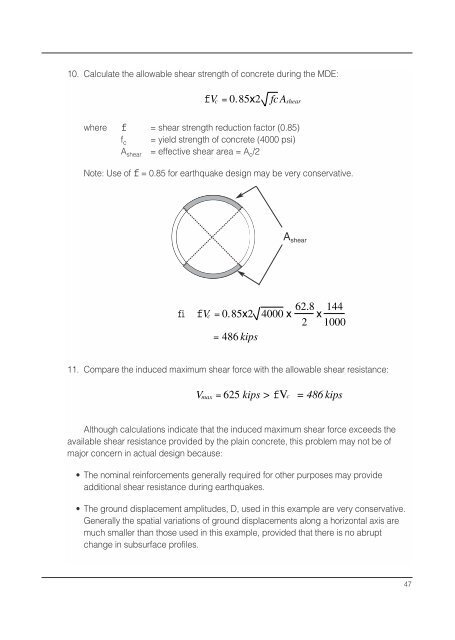Seismic Design of Tunnels - Parsons Brinckerhoff
Seismic Design of Tunnels - Parsons Brinckerhoff
Seismic Design of Tunnels - Parsons Brinckerhoff
You also want an ePaper? Increase the reach of your titles
YUMPU automatically turns print PDFs into web optimized ePapers that Google loves.
10. Calculate the allowable shear strength <strong>of</strong> concrete during the MDE:<br />
fV c = 0.85x2<br />
fc A shear<br />
where f = shear strength reduction factor (0.85)<br />
f c = yield strength <strong>of</strong> concrete (4000 psi)<br />
A shear = effective shear area = A c /2<br />
Note: Use <strong>of</strong> f = 0.85 for earthquake design may be very conservative.<br />
A shear<br />
fi fVc = 0.85x2 4000 x 62.8<br />
2 x 144<br />
1000<br />
= 486 kips<br />
11. Compare the induced maximum shear force with the allowable shear resistance:<br />
V max = 625 kips > fVc<br />
= 486 kips<br />
Although calculations indicate that the induced maximum shear force exceeds the<br />
available shear resistance provided by the plain concrete, this problem may not be <strong>of</strong><br />
major concern in actual design because:<br />
• The nominal reinforcements generally required for other purposes may provide<br />
additional shear resistance during earthquakes.<br />
• The ground displacement amplitudes, D, used in this example are very conservative.<br />
Generally the spatial variations <strong>of</strong> ground displacements along a horizontal axis are<br />
much smaller than those used in this example, provided that there is no abrupt<br />
change in subsurface pr<strong>of</strong>iles.<br />
47
















